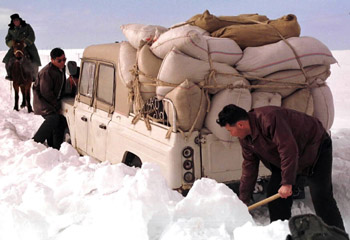| Tools: Save | Print | E-mail | Most Read |
| China Questions and Answers |
| Adjust font size: |
Q: The Indian Ocean earthquake and tsunami in 2004 caused huge disaster in Southeast Asian countries. Has China designated a special department to be responsible for disaster mitigation and relief work? What measures does China usually adopt to handle disasters when they occur? A: The considerable loss of life and destruction of property the Indian Ocean tsunami caused to countries in Southeast Asia warned China against the improper handling of such disasters. China is among countries severely affected by natural disasters. With the exception of volcanic eruptions, almost all kinds of natural disasters occur in different regions of China. Government statistics show that direct loss resulting from disasters totals over 100 billion yuan (US$12.1 billion) each year. The Chinese Government attaches great importance to disaster mitigation and relief work due to the frequency of disaster occurrence. When a severe disaster happens, state leaders will come to inspect the affected areas and comfort victims, in addition to mobilizing manpower and material resources, and financial support to help people cope. In 2004, severe floods occurred in some medium and small rivers and Typhoon Rananim hit east China's Zhejiang Province, causing landslides, falling rocks and flash floods in certain townships. Apart from strengthening disaster early-warning and forecast efforts, the Central Government earmarked 4 billion yuan (US$483.68 million) for disaster relief in these areas, collected donations of 4.89 million yuan (US$591,294), allocated 310,000 tents, evacuated and settled down 6.11 million victims in disaster-stricken areas, and helped these victims to rebuild 1.4 million destroyed houses, guaranteeing the basic needs of victims in terms of clothing, food, shelter, clean water and medical care. To supplement the government support, people from all walks of life are encouraged to donate and help the disaster-hit areas. Victims were encouraged to brace themselves for the relief work, neighboring cities were asked to help each other to pull through disasters, and tax breaks were granted. All these measures helped assist the basic needs of victims and guarantee social stability in disaster-stricken areas. China has spent a considerable amount of money building disaster early-warning and forecast mechanisms to monitor and forecast, respectively, earthquake and weather events. These investments greatly enhanced the country's earthquake monitoring ability and technology for forecasting weather conditions. As well, China has achieved a distinct improvement in technologies for marine environment forecasting, dynamic monitoring and early warning of severe plant diseases and insects, as well as weather calamities. As for the construction of disaster prevention and relief mechanisms, China has established an emergency relief mechanism for severe disasters, detailed emergency response procedures for the Central Government, and formed a nationwide contingency planning system for emergency disaster response at provincial, prefecture and county level governments. The nationwide network of disaster information, reaching every county, has been launched and ensures severe disasters are dealt with within 24 hours of occurring. Under the leadership of all levels of government, an emergency disaster relief mechanism that involves disaster relief departments at all levels, the military, the police as well as the reserve forces as its backbone has been in place. A system for disaster relief emergency appropriation and the disaster relief material reserve mechanism have been established by the Central Government, greatly enhancing emergency relief ability at all levels of government. China has also invested heavily in disaster mitigation engineering plans and finished several large water conservancy projects, fixed embankments over trunk rivers and dilapidated reservoirs, and developed flood and earthquake resistant facilities in major cities as well as comprehensive prevention and control engineering techniques for heavy disasters. In order to guarantee smooth disaster prevention, mitigation and relief, China has enacted and put into force some 30 relevant laws and regulations. The implementation of the Law on Water and Soil Conservation, the Law on Precautions Against Earthquakes and Relief of Disaster, the Fire Control Law, the Flood Control Law, the Meteorology Law, the Work Safety Law as well as the Regulations on Forest Fire Prevention, the Regulations on Forest Disease and Insect Pest Prevention and Control, and the Regulations on the Control over Safety of Dangerous Chemicals, in particular, enables the above-mentioned fields of work and forms the working pattern of mitigating and relieving disasters in accordance with the law.
|
| Tools: Save | Print | E-mail | Most Read |
 |
| Related Stories |
|
Product Directory China Search |
Country Search Hot Buys |
